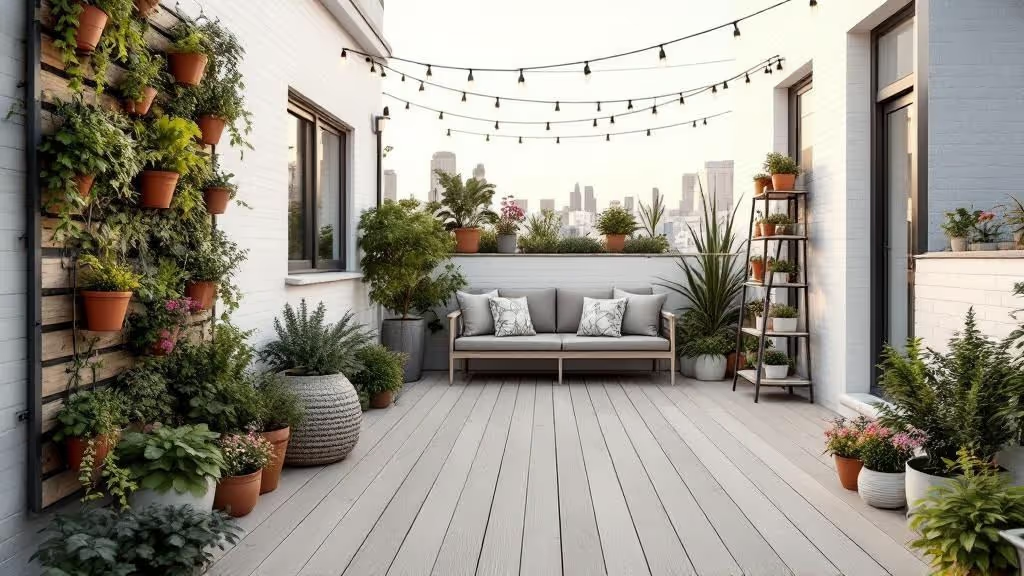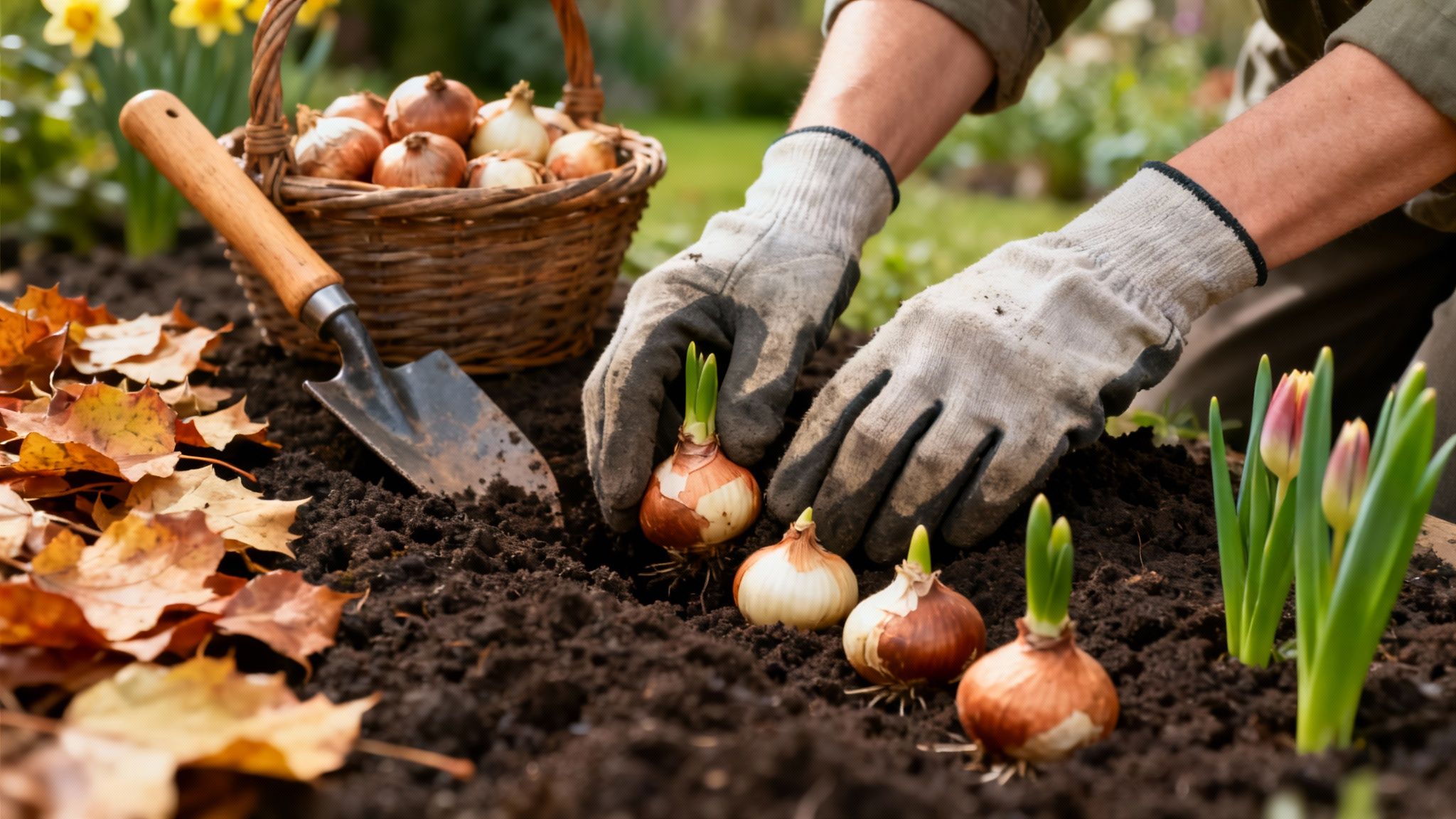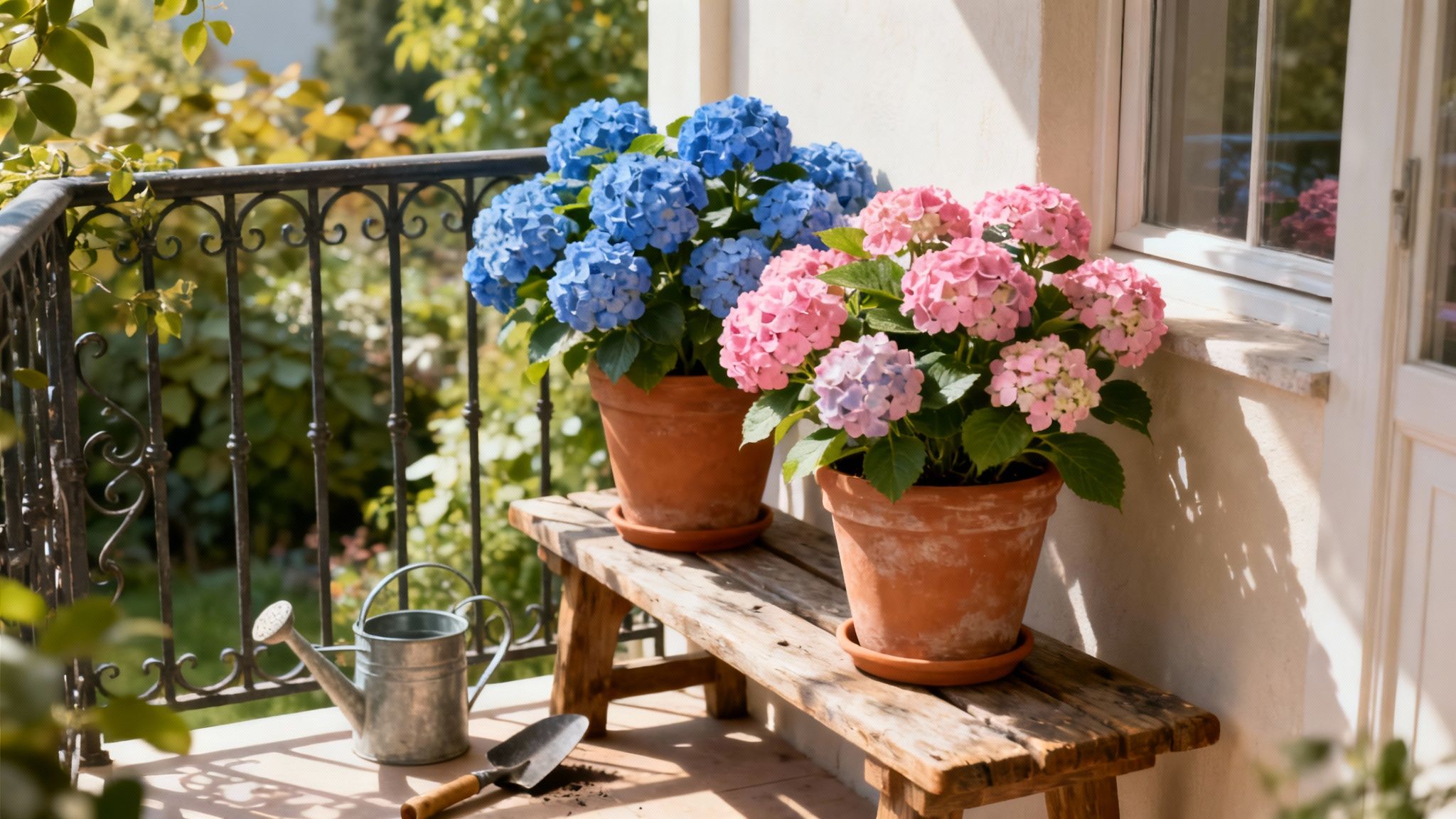Living in a terrace house often means working with a compact outdoor area, but a small footprint doesn't have to limit your gardening ambitions. The classic British terrace garden is a unique canvas for creativity, offering the opportunity to craft a private, green sanctuary right in the heart of your neighbourhood. Whether you possess a narrow yard, a small stone patio, or even just a concrete balcony, the right design can transform it into a lush, functional, and beautiful extension of your home.
This guide moves beyond generic advice to explore 10 innovative and practical terrace house garden ideas, providing you with specific, actionable strategies. We'll delve into everything from maximising vertical space with living walls and creating bountiful container gardens to designing urban wildlife havens and integrating edible landscapes. Each idea is tailored to address the common challenges of terraced living, such as limited space, overlooking neighbours, and awkward layouts. Prepare to unlock your garden's true potential and see your small outdoor space in a completely new light.
1. Vertical Garden Living Wall
When ground space is at a premium, the only way to go is up. A vertical garden, or living wall, is one of the most impactful and space-efficient terrace house garden ideas available. It transforms a bland brick wall or fence into a lush, vibrant tapestry of foliage, adding a dramatic focal point and maximising your growing area without sacrificing a single square centimetre of floor space.

This approach, popularised by pioneers like Patrick Blanc, involves growing plants in modular panels, felt pockets, or integrated hydroponic systems fixed directly to a vertical surface. The result is a stunning, soil-free garden that can host everything from ornamental ferns and grasses to herbs and edible greens.
How to Implement a Living Wall
- Choose Your System: Select from modular plastic planters, fabric pocket systems like those from Woolly Pocket, or more advanced hydroponic setups.
- Ensure Structural Support: The wall must be strong enough to hold the weight of the system, plants, and water.
- Plan for Irrigation: A built-in drip irrigation system is crucial for consistent watering and preventing dry spots.
- Select a Lightweight Medium: Use a specialist lightweight growing medium to reduce the overall load on the wall.
- Plant Smart: Group plants with similar light and water needs together. For a sunny wall, try herbs like thyme and rosemary. For shadier spots, heucheras, ferns, and hostas are excellent choices.
A well-executed living wall not only provides aesthetic beauty but also improves air quality and can even help to insulate your home. To delve deeper into creating a striking feature wall, you can find more inspiration for your own vertical garden feature on sprucecollective.co.uk.
2. Container and Pot Garden
Perhaps the most flexible and adaptable of all terrace house garden ideas, the container and pot garden offers complete creative control. This approach uses a collection of pots, troughs, and planters to create a portable garden that can be rearranged to suit the seasons, your mood, or changing light conditions. It’s the perfect solution for renters or anyone who enjoys refreshing their outdoor space without the commitment of in-ground planting.
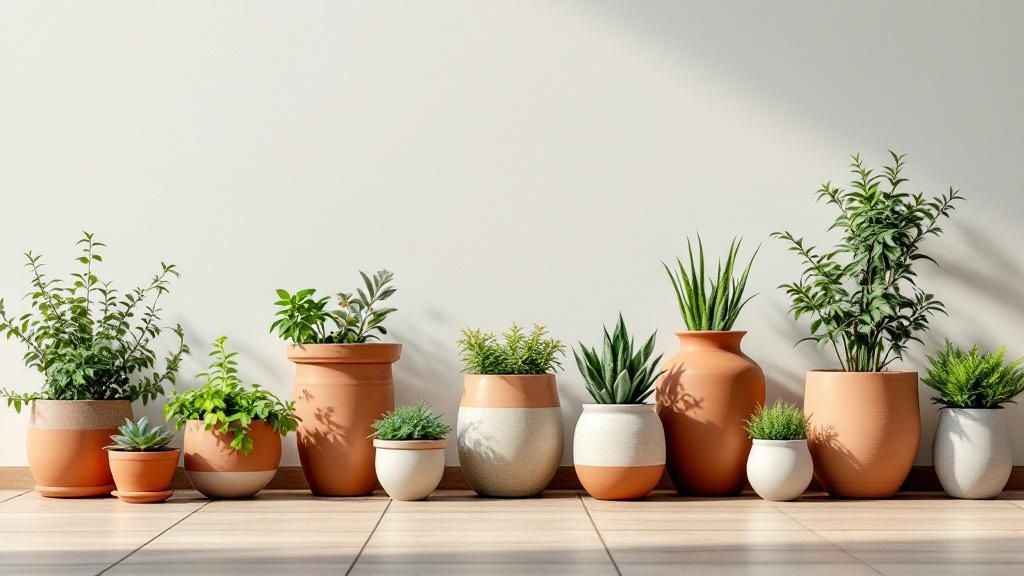
This method has been championed by gardening authorities like Monty Don and Sarah Raven, who demonstrate how to create stunning, layered displays with everything from ornamental trees to vibrant cutting flowers. A well-curated container garden transforms a patio or deck into a dynamic, personalised oasis, allowing you to cultivate a diverse range of plants even in the smallest of areas.
How to Implement a Container Garden
- Group for Impact: Arrange containers in clusters, typically in odd numbers (3, 5, or 7), to create a more natural and visually pleasing composition.
- Vary Heights and Textures: Mix tall planters with low bowls and use a variety of materials like terracotta, glazed ceramic, and metal to add depth and interest.
- Choose the Right Size: Select a pot that is at least twice the size of the plant's root ball to allow for healthy growth and reduce the need for frequent watering.
- Use Quality Compost: Fill your containers with a high-quality, peat-free potting mix rather than garden soil, which compacts easily and offers poor drainage.
- Protect Your Surfaces: Place saucers or pot feet underneath your containers to catch excess water, prevent staining on paving, and improve drainage.
A container garden is a fantastic way to experiment with different plants and colour schemes. For more in-depth guidance on creating beautiful pot displays, the Royal Horticultural Society provides an excellent resource on their website.
3. Raised Bed Gardens
For terrace houses with poor native soil or concrete-covered yards, raised bed gardens offer a perfect, structured solution. These are essentially garden boxes, elevated from ground level and filled with a high-quality soil mix, giving you complete control over your growing environment. This method neatly bypasses issues like soil compaction, poor drainage, and weeds, making it one of the most practical terrace house garden ideas.
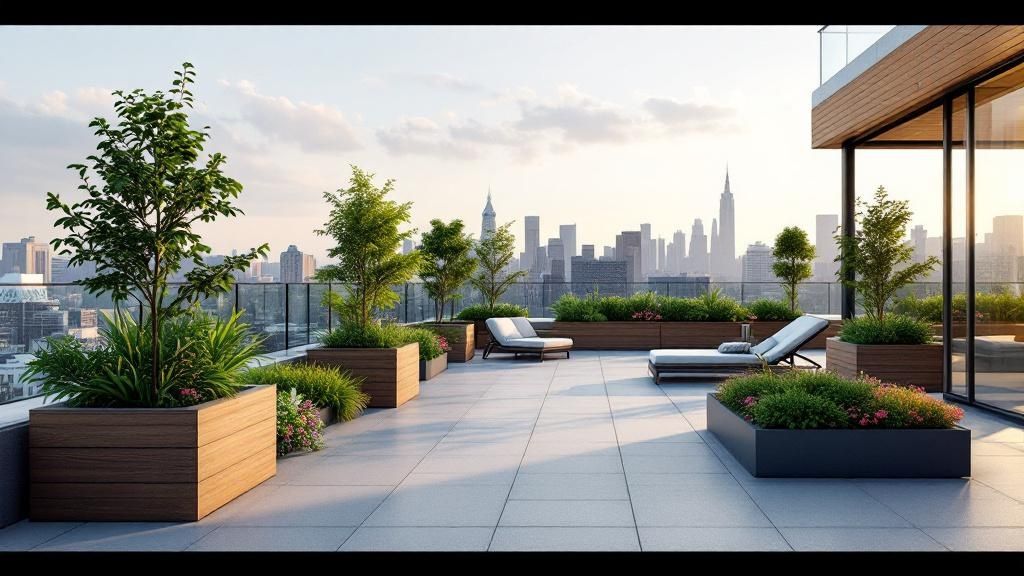
This approach, championed by gardeners like Mel Bartholomew with his "Square Foot Gardening" method, allows for intensive planting in a small footprint. From the neat vegetable plots in Victorian terrace gardens to productive urban farms, raised beds provide a defined, manageable, and highly productive space for growing anything from root vegetables to cut flowers.
How to Implement Raised Bed Gardens
- Mind the Width: Construct beds no wider than 4 feet (1.2 metres). This ensures you can comfortably reach the centre from either side without stepping on the soil.
- Choose Durable Materials: Cedar is a popular choice for its natural rot resistance, while modern composite materials offer excellent longevity with minimal maintenance.
- Create the Perfect Soil: Fill your beds with a high-quality mix for optimal growth. A classic recipe is one-third compost, one-third peat moss or coir, and one-third vermiculite for aeration.
- Install Efficient Irrigation: A simple drip irrigation system or soaker hose laid on the soil surface provides consistent moisture directly to the plant roots, saving water and time.
- Plan Your Planting: Use multiple beds to practise crop rotation, which helps to prevent soil-borne diseases and nutrient depletion.
Raised beds are especially effective at bringing order and definition to a space. For more tips on using structured elements in a smaller space, you can explore further ideas for a long, narrow garden on sprucecollective.co.uk.
4. Rooftop Garden Terrace
For terrace houses with accessible flat roofs, creating a rooftop garden terrace is the ultimate way to reclaim unused space and carve out a private urban oasis. This ambitious idea transforms a barren expanse into a productive and beautiful garden, offering unparalleled views and a genuine escape from the city bustle below. It's a prime example of maximising a home's footprint in dense urban environments.
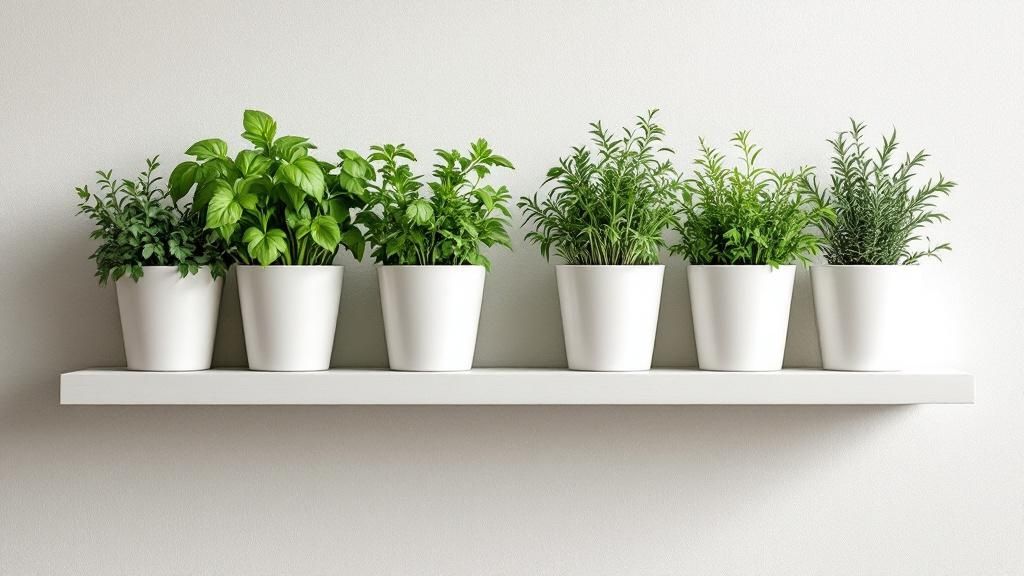
Inspired by the urban farming movement and pioneering projects like the Brooklyn Grange in New York, this approach involves careful planning around structural integrity, weight loads, and exposure to the elements. The result is a stunning, elevated garden that can be used for growing vegetables, entertaining guests, or simply relaxing in the sun, making it one of the most rewarding terrace house garden ideas.
How to Implement a Rooftop Garden
- Consult a Structural Engineer: This is a non-negotiable first step. You must verify the roof's load-bearing capacity to ensure it can safely support the weight of soil, containers, plants, and people.
- Use Lightweight Materials: Opt for fibreglass or plastic containers instead of heavy terracotta or concrete. Use a lightweight compost mix combined with perlite to reduce the overall load.
- Install Windbreaks: Rooftops are exposed to strong winds. Install trellis, slatted screening, or hardy hedging plants like bamboo (in containers) to protect more delicate species.
- Plan for Water and Drainage: Ensure there is adequate drainage to prevent waterlogging and structural damage. An efficient drip irrigation system on a timer is ideal for consistent watering in a hot, windy environment.
- Choose Hardy Plants: Select plants that can tolerate sun, wind, and drought. Mediterranean herbs like lavender and rosemary, grasses such as Stipa tenuissima, and succulents like sedums are excellent choices.
A rooftop garden provides a unique opportunity for city dwellers to connect with nature. For more guidance on the technical aspects of green roof construction, you can find valuable resources from organisations like The Green Roof Organisation (GRO).
5. Small Space Herb Garden
For those who love to cook, a small space herb garden is one of the most rewarding terrace house garden ideas. It transforms even the tiniest patio or windowsill into a fragrant, productive patch, providing fresh flavours for your kitchen just a few steps away. This idea moves beyond simple potted plants, encouraging a thoughtfully designed culinary collection that is both beautiful and intensely practical.
This approach, championed by culinary figures like Jamie Oliver and herb experts such as Jekka McVicar, focuses on creating maximum utility in minimal space. It’s about curating a selection of herbs you will genuinely use, arranging them for optimal growth and easy access. Imagine stepping outside to snip fresh basil for a pasta sauce or mint for a refreshing drink.
How to Implement a Small Herb Garden
- Group by Needs: Plant herbs with similar sun and water requirements together. For example, Mediterranean herbs like rosemary, thyme, and oregano love sun and drier soil, while mint and parsley prefer more moisture.
- Contain Aggressive Growers: Always plant mint and its relatives in their own pots. Their roots spread aggressively and will quickly take over a mixed planter.
- Harvest Regularly: Frequent trimming encourages bushier, healthier growth and provides you with a constant supply of fresh leaves.
- Start with the Essentials: If you're new to herb gardening, begin with easy-to-grow favourites like parsley, chives, mint, and rosemary.
- Use Tiered Planters: A tiered or vertical planter allows you to grow more in a smaller footprint, perfect for a terrace house setup.
An herb garden is an excellent choice for a terrace as it offers sensory delight with wonderful scents and textures, while also being incredibly useful. For more tips on maximising your grow-space, discover other small space gardening ideas at sprucecollective.co.uk.
6. Modern Minimalist Garden
In the context of terrace house garden ideas, less is often profoundly more. A modern minimalist garden champions clean lines, a restricted plant palette, and high-quality architectural elements. This approach prioritises form, texture, and structure over a riot of colour and abundant planting, creating a serene, uncluttered outdoor space that feels both sophisticated and calming.
Inspired by the principles of designers like Christopher Bradley-Hole and the structured naturalism of Piet Oudolf, this style turns the garden itself into a piece of art. It focuses on the interplay between hardscaping, such as polished concrete or slate paving, and a few carefully chosen plant species with strong architectural forms. The result is a powerful, elegant statement, perfect for a contemporary terrace house.
How to Implement a Minimalist Garden
- Choose Architectural Plants: Select plants for their shape and form. Think of the sculptural quality of ornamental grasses like Calamagrostis 'Karl Foerster', the strong vertical lines of bamboo, or the evergreen structure of clipped topiary.
- Embrace Repetition: Repeat a limited selection of plants and materials throughout the space. This creates rhythm and a strong sense of cohesion, preventing the garden from looking busy.
- Invest in Quality Hardscaping: The materials you choose are central to the design. Use high-quality pavers, timber, or gravel to create crisp, defined edges and pathways that guide the eye.
- Focus on a Textural Palette: Build interest through the contrast of textures rather than colours. Combine smooth, rendered walls with rough-hewn timber, and pair glossy leaves with the soft plumes of grasses.
A minimalist garden is a testament to disciplined design, offering a low-maintenance yet high-impact solution that extends your modern interior style outdoors. This clean aesthetic shares principles with other interior trends, and you can explore how this sense of refined simplicity is achieved in our guide to modern country decorating.
7. Urban Wildlife Garden
Your terrace house garden can be more than just a pretty space; it can become a vital sanctuary for local wildlife. An urban wildlife garden is intentionally designed to attract and support birds, bees, butterflies, and beneficial insects, creating a miniature ecosystem right outside your back door. This approach transforms even the smallest plot into a bustling hub of nature, contributing positively to local biodiversity.
Pioneered by experts like Chris Baines and championed by organisations such as the RHS, this idea focuses on creating habitats and providing food sources within the constraints of a typical terraced property. By choosing the right plants and features, you can turn your garden into a crucial stepping stone for wildlife navigating the urban landscape, making it one of the most rewarding terrace house garden ideas.
How to Implement an Urban Wildlife Garden
- Plant for Pollinators: Choose nectar-rich flowers that bloom across different seasons to provide a year-round food source. Good choices include lavender, buddleia (butterfly bush), verbena bonariensis, and single-flowered dahlias.
- Provide a Water Source: A shallow dish of water with pebbles or marbles for insects to land on can serve as a bird bath and a drink for bees.
- Create Vertical Habitats: Use climbers like ivy or honeysuckle against walls and fences to offer shelter and nesting sites for birds and insects.
- Embrace the Mess: Leave a small pile of logs, twigs, or fallen leaves in a quiet corner. This provides a crucial habitat for insects, hedgehogs, and amphibians.
- Go Chemical-Free: Avoid pesticides and herbicides, which harm beneficial insects and disrupt the natural food chain. Encourage natural predators like ladybirds to control pests.
A well-planned wildlife garden not only supports nature but also provides endless opportunities for observation and connection with the natural world. For more detailed guidance, the RHS offers extensive resources on creating a garden for wildlife that are perfect for beginners.
8. Edible Landscape Integration
Why choose between a beautiful garden and a productive one when you can have both? Edible landscape integration is one of the most rewarding terrace house garden ideas, blending food-producing plants seamlessly into an ornamental design. This approach, championed by visionaries like Rosalind Creasy, moves beyond traditional vegetable patches, turning your entire garden into a beautiful space that also provides fresh, delicious produce.
Instead of hiding away your veggies, this method celebrates their beauty. The striking red veins of a 'Bright Lights' chard can be just as stunning as any foliage plant, and the architectural form of an artichoke can create a powerful focal point. It's about combining aesthetic appeal with practical food production for a truly multisensory garden experience.
How to Implement an Edible Landscape
- Choose Attractive Varieties: Opt for visually appealing vegetables like rainbow chard, purple-podded peas, or frilly lettuces.
- Use Fruit Trees for Structure: A compact, espaliered apple or pear tree against a fence provides year-round structure, spring blossom, and autumn fruit.
- Include Edible Flowers: Scatter nasturtiums, calendula, and borage throughout your beds. They add vibrant colour and can be used to garnish salads.
- Mix Herbs Throughout: Use herbs like rosemary, thyme, and sage as fragrant, low-growing ground cover or border edging.
- Plan for Succession: As you harvest one crop, have another seedling ready to take its place to keep your beds looking full and productive.
An edible landscape connects you directly to your food source while creating a dynamic, ever-changing garden design. To see how beautifully this concept can be executed, explore the principles behind the ornamental kitchen gardens at River Cottage.
9. Mediterranean Drought-Tolerant Garden
Embrace a water-wise and stunningly atmospheric approach with a Mediterranean-inspired garden. This is one of the most sustainable and low-maintenance terrace house garden ideas, perfect for sun-drenched, south-facing spaces. It champions plants that thrive in hot, dry conditions, creating a resilient garden that requires minimal watering once established and evokes the sun-baked landscapes of Provence or the Greek islands.
Popularised by horticultural pioneers like Beth Chatto and Olivier Filippi, this style relies on excellent drainage and a palette of silver-leafed, aromatic, and architectural plants. By mimicking their native habitat with gravel mulches and free-draining soil, you can cultivate a beautiful and environmentally conscious urban oasis that flourishes even through drier summers.
How to Implement a Mediterranean Garden
- Prioritise Drainage: This is non-negotiable. Amend heavy clay soil with generous amounts of grit and organic matter, or use raised beds filled with a gritty compost mix.
- Use Gravel Mulch: A top layer of gravel or small stones suppresses weeds, conserves moisture in the soil below, and reflects heat, keeping plant roots cool.
- Choose the Right Plants: Opt for classic Mediterranean choices like lavender, rosemary, santolina, and thyme. Add structural interest with phormiums or cordylines and soft texture with grasses like Stipa tenuissima.
- Plant in Autumn: Planting in autumn allows root systems to establish over the winter, making them much more resilient to drought the following summer.
- Group by Water Needs: Even within a drought-tolerant scheme, some plants need more water than others. Grouping them accordingly makes watering more efficient.
This gardening style is a fantastic solution for creating a garden that is both beautiful and resilient in the face of changing climate patterns. To explore more ways to create a garden that looks after itself, you can find further inspiration for your own low maintenance garden on sprucecollective.co.uk.
10. Multi-Level Terraced Design
For terrace house gardens with a natural slope, or for those looking to create dramatic verticality on a flat plot, a multi-level terraced design is a game-changing solution. This approach carves the space into distinct tiers or platforms, connected by steps or gentle slopes. It’s an incredibly effective way to manage a challenging gradient while maximising usable planting areas and creating a dynamic, journey-like experience within a compact garden.
This technique draws inspiration from ancient hillside farming and grand Italian Renaissance gardens, but it is perfectly adapted for modern urban plots, such as London townhouse gardens. Each level can be treated as a mini-garden room, hosting different functions from a dining patio on one tier to a lush perennial border on another. It's one of the most structural and transformative terrace house garden ideas.
How to Implement a Terraced Design
- Plan for Drainage: Proper drainage is non-negotiable. Ensure each level has weep holes or a system to allow water to escape, preventing waterlogging and pressure on the retaining walls.
- Choose Complementary Materials: Select materials for retaining walls and steps - like sleepers, Corten steel, or brick - that complement the architecture of your house for a cohesive look.
- Create Easy Access: Design clear, safe pathways or steps between the levels. The journey should feel intuitive and inviting, not like an obstacle course.
- Layer Your Planting: A classic design principle is to place taller plants and shrubs at the back of each tier (or on the highest level) with shorter plants at the front to create depth and preserve views.
- Seek Structural Advice: For retaining walls over a metre high, it is wise to consult a structural engineer to ensure they are built safely and can withstand the pressure of the soil behind them.
A multi-level design turns a simple, sloped garden into a sophisticated and highly functional space, providing visual interest and defined zones for planting and relaxation. To see how professionals tackle these designs, explore the portfolio of a leading landscape architecture firm like Charlotte Rowe Garden Design.
Terrace House Garden Ideas Comparison Table
Cultivating Your Perfect Terrace Garden
We have explored a wealth of inspiring terrace house garden ideas, from the space-saving brilliance of vertical living walls to the productive elegance of edible landscapes and the chic simplicity of modern minimalist designs. The journey from a bare, overlooked terrace to a vibrant, personal sanctuary is not about having the largest space, but about making the smartest, most creative choices for the space you have. The core takeaway is that constraints breed creativity. A narrow footprint encourages vertical thinking, limited sunlight guides you towards shade-loving wonders, and a busy lifestyle makes low-maintenance, drought-tolerant gardens a practical and stylish choice.
Key Principles for Terrace Transformation
Remember the fundamental principles that thread through all these concepts. Firstly, maximise your vertical plane. Whether through trellises, wall-mounted planters, or a full-scale living wall, drawing the eye upwards creates an illusion of space and lushness. Secondly, choose your containers wisely. The pots, troughs, and raised beds you select are not just vessels for soil; they are crucial design elements that define your garden's character, from rustic terracotta for a Mediterranean feel to sleek fibreglass for a contemporary look. Finally, embrace multi-functionality. Your garden can be beautiful and productive, a wildlife haven and a minimalist retreat. A single raised bed can support a 'three sisters' planting of corn, beans, and squash, providing food, visual interest, and a lesson in companion planting.
Your Actionable Next Steps
Feeling inspired? It's time to translate that inspiration into action.
- Assess Your Space: Before buying a single plant, take precise measurements. Note the sun's path throughout the day, identify windy spots, and check access to a water source. This foundational step will prevent costly mistakes.
- Define Your Garden's Purpose: What do you want from your garden? A quiet reading nook? A source of fresh herbs for your kitchen? A colourful playground for pollinators? Your primary goal will guide every subsequent decision.
- Create a Simple Plan: Sketch your layout. It doesn't need to be an architectural masterpiece. A simple diagram will help you visualise where larger elements like raised beds or a small bistro set will go, ensuring a practical and harmonious flow.
- Start Small: Don't feel pressured to complete your entire garden in one weekend. Begin with a cluster of containers or a single raised bed. Success in a small area will build your confidence to expand your green oasis over time.
By thoughtfully applying these terrace house garden ideas, you can craft an outdoor space that not only enhances your home's value but profoundly enriches your daily life. It becomes a place to connect with nature, to unwind after a long day, and to express your personal style. Your perfect terrace garden is waiting to be realised; all it takes is a little planning, a touch of creativity, and the first step of planting a seed.

